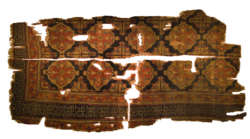Oriental rugs, antique and modern (1922) (14777408791)
Identifier: orientalrugsanti1922hawl (find matches)
Title: Oriental rugs, antique and modern
Year: 1922 (1920s)
Authors: Hawley, W. A. (Walter Augustus), 1863-1920
Subjects: Rugs, Oriental
Publisher: New York, Dodd, Mead
Contributing Library: Sterling and Francine Clark Art Institute Library
Digitizing Sponsor: Sterling and Francine Clark Art Institute Library
View Book Page: Book Viewer
About This Book: Catalog Entry
View All Images: All Images From Book
Click here to view book online to see this illustration in context in a browseable online version of this book.
Text Appearing Before Image:
Many of them are COLOUR PLATE VII—LADIK PRAYER RUG The rug here represented conforms in every particular to one of thebest types of Ladik prayer rugs. It contains the beautiful border stripeof Rhodian lilies, the pomegranates and Vandykes in the panel belowthe central field, and the queer designs of scrolls and serrated leaves sopeculiar to these rugs. It is interesting to see how the pattern of theinnermost stripe, which consists of a row of S-forms at the top and sides,is changed so as to resemble a ribbon at the bottom, to note the eight-pointed stars resting on octagons in the lower panel, so suggestive ofnomads, and also the designs which have been placed near the two cornerson the left, between the rosettes and Rhodian lilies of the main stripe,as if to divert the spell of the evil-eye. Such irregularities, denotingthe idiosyncrasies of the weaver, add to the charm of Oriental rugs. Loaned by Mr. Hulett C. Merritt ■ ••V W.»v;. ,-*,. ■;;j!.lli,;»V • ! j ,V, H M j M
Text Appearing After Image:
v.- * ASIA MINOR RUGS 191 prayer rugs with arches resembling the Ghiordes pattern, but theirborders are more conventional. Woollen rugs which are copies ofother well-known Asia Minor pieces are also woven there. Yuruks. — Suggestive of gipsies, yet widely unlike them, arethe tribes of Turkoman descent known as Yuruks. This termmeans Wanderers; and they are well named, since throughout thewestern part of Asia Minor they follow their sheep, cattle, andcamels from the rich pastures among the mountain tops of the in-terior, where they live in summer, to the fertile, sunny plains border-ing the seashore in winter. Even near Smyrna and the slopes ofMt. Olympus may be seen their black goats-hair tents, where theunexpected guest is always welcome. In their rugs is the reflection of their untrammelled lives, un-affected by the refinements of cities; and as their lives are differ-ent from those of all other inhabitants of Asia Minor, so are theserugs entirely distinct, resembling more than an
Note About Images
Relevante Bilder
Relevante Artikel
Anatolischer TeppichEin anatolischer Teppich, auch türkischer Teppich genannt, ist ein geknüpfter Orientteppich, der in Anatolien und den angrenzenden Regionen in Handarbeit produziert wird. Anatolische Teppiche bilden ebenso wie Kelims einen wichtigen Bestandteil des kulturellen Erbes der heutigen Türkei. .. weiterlesen










































